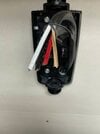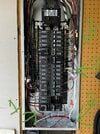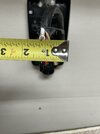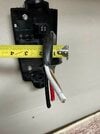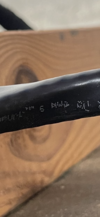I had an electrician install the wire for our wall charger. However, I wasn’t done sheet rocking the walls, so I had him just leave the wire un-terminated and he taped up the end. Now that I have the wall finished I went back to wire the charger and found that there are 4 wires and everything I’ve found only shows how to connect 3. I was hoping for some advice on how to hook up the wires.
Welcome to Tesla Motors Club
Discuss Tesla's Model S, Model 3, Model X, Model Y, Cybertruck, Roadster and More.
Register
Install the app
How to install the app on iOS
You can install our site as a web app on your iOS device by utilizing the Add to Home Screen feature in Safari. Please see this thread for more details on this.
Note: This feature may not be available in some browsers.
-
Want to remove ads? Register an account and login to see fewer ads, and become a Supporting Member to remove almost all ads.
You are using an out of date browser. It may not display this or other websites correctly.
You should upgrade or use an alternative browser.
You should upgrade or use an alternative browser.
Wall charger installation question
- Thread starter tkt546
- Start date
On the picture, the wire is coming in at the bottom (2).You really need to look at how it was wired in the panel. A 240 circuit doesn’t need a neutral so you should have two hot legs and ground, so one of those is un-needed. But I wouldn’t connect anything until you confirm in the panel or check with the electrician.
The red and black are wired to the breaker (1).
The white is wired to strip with other white wires (3).
The bare wire is wired to strip with other bare wires (4).
Attachments
I’m assuming this is your primary panel and not a sub-panel? If that’s the case, ground and neutral are likely bonded together, so you could connect either the bare copper or white to the ground terminal on the Tesla charger.On the picture, the wire is coming in at the bottom (2).
The red and black are wired to the breaker (1).
The white is wired to strip with other white wires (3).
The bare wire is wired to strip with other bare wires (4).
If however this is a sub-panel, ground and neutral are likely not bonded, so you’ll have to connect the bare copper lead.
Another thing to note, you’ve got a lot of circuits on your 150 amp service. You might run into trouble is you try to charge at a full 48 amps.
mike01
Member
Disclaimer: I’m not an electrician.
The white wire (neutral) isn’t needed for the wall charger. You just need the red and black (the 2 hots) and the bare wire (ground). I would simply put a wire nut over the end of the unneeded white neutral wire to protect it.
The white wire (neutral) isn’t needed for the wall charger. You just need the red and black (the 2 hots) and the bare wire (ground). I would simply put a wire nut over the end of the unneeded white neutral wire to protect it.
Yes, this is the only panel in the house. The white wires are are tapped to the strips on either side and are connected to the big black and white striped cable at the top.I’m assuming this is your primary panel and not a sub-panel? If that’s the case, ground and neutral are likely bonded together, so you could connect either the bare copper or white to the ground terminal on the Tesla charger.
If however this is a sub-panel, ground and neutral are likely not bonded, so you’ll have to connect the bare copper lead.
Another thing to note, you’ve got a lot of circuits on your 150 amp service. You might run into trouble is you try to charge at a full 48 amps.
You can’t see it in the picture, but the bare wires are are tapped to a small strip, screwed directly into the back wall of the metal box.
As for the load on the service, I have no clue. I had them replace the entire box and re-wire everything, and this is what they did. I assumed they knew what they were doing and it was correct.
Yes, they are. The angle of the picture is a little misleading.Maybe I missed something but can you confirm red and black are on same breaker?
ucmndd
Well-Known Member
Cap the white wire and use the other three. The wall connector doesn’t use a neutral.
Easy peasy.
Easy peasy.
el-guapin
Trust no One
I think I can make out a 6 on the wire, but it’s not really readable. I had taken pictures of how thick it was.is that 8 gauge or 6 gauge wire?
Attachments
I think that says 6 AWG, but that’s the only legible writing I can find.is that 8 gauge or 6 gauge wire?
Attachments
It’s “technically” 55 amps, but most electricians will round up since a 55 amp breaker doesn’t exist and you are limited to 48 amps by the Wall Charger itself.I thought the max amperage for a romex 6/3 was 50 amps. Yours looks like it is hooked up to a 60 amp breaker
In the US generally speaking, and depending on the install, this can get more complicated, so talk to an electrician.I thought the max amperage for a romex 6/3 was 50 amps. Yours looks like it is hooked up to a 60 amp breaker
6/3/NM-B is rated at 55 amps. They do not sell a 55 amp breaker, so NEC allows you to go up to the next available size of 60.
For a hardwired charger you still need to de-rate your charge amperage to 80% based on the size of the wires not the breaker. For 6/3NM-B that would be 80% of 55 or 44 Amps max charge rate. If you use THWN in a conduit you can charge at 48 amps.
However if you are hooking it up to a 50 amp receptacle (14-50, etc.), you have to derate your charge amperage to 40 amps.
It's true that many electricians do that, but it is obviously, blatantly a code violation. The wire must meet the circuit rating. And running a continuous current of 48A would mean that the full rating of the circuit must be 125% of that, or a full actual 60A circuit. That 6 gauge Romex is only able to meet a rating of 55A, so it is insufficient for a 60A circuit. It's just wrong.It’s “technically” 55 amps, but most electricians will round up since a 55 amp breaker doesn’t exist and you are limited to 48 amps by the Wall Charger itself.
Even a lot of electricians seem to misunderstand that round up case a lot of the time. We see this constantly in this forum.
NEC 240.4(B) Overcurrent Devices Rated 800 Amperes or LessIt's true that many electricians do that, but it is obviously, blatantly a code violation. The wire must meet the circuit rating. And running a continuous current of 48A would mean that the full rating of the circuit must be 125% of that, or a full actual 60A circuit. That 6 gauge Romex is only able to meet a rating of 55A, so it is insufficient for a 60A circuit. It's just wrong.
Even a lot of electricians seem to misunderstand that round up case a lot of the time. We see this constantly in this forum.
The next higher standard overcurrent device rating (above the ampacity of the conductors being protected) shall be permitted to be used, provided all of the following conditions are met:
The conductors being protected are not part of a branch circuit supplying more than one receptacle for cord-and-plug-connected portable loads.
The ampacity of the conductors does not correspond with the standard ampere rating of a fuse or a circuit breaker without overload trip adjustments above its rating (but that shall be permitted to have other trip or rating adjustments).
The next higher standard rating selected does not exceed 800 amperes.
Uh huh. And notice what is NOT included in there? It DOES NOT say that you can then treat the entire circuit as if it is the full rating of the oversized breaker that was put on. THAT is the point. The wire is still a lower limiting factor and does not get an oversized rating or rounded up, so you don't get to use the whole circuit that way.NEC 240.4(B) Overcurrent Devices Rated 800 Amperes or Less
The next higher standard overcurrent device rating (above the ampacity of the conductors being protected) shall be permitted to be used, provided all of the following conditions are met:
The conductors being protected are not part of a branch circuit supplying more than one receptacle for cord-and-plug-connected portable loads.
The ampacity of the conductors does not correspond with the standard ampere rating of a fuse or a circuit breaker without overload trip adjustments above its rating (but that shall be permitted to have other trip or rating adjustments).
The next higher standard rating selected does not exceed 800 amperes.
We are not saying that the act of just putting the 60A breaker on is the code violation. But it is how the entire circuit gets used. People put that breaker on, but then think they can run 48A continuous through 55A rated wire, and that is where the code violation lies. I have mentioned this in another thread, that there is at least one brand of EVSE for car charging that specifically does have a 44A setting that is to be used for 55A circuits. That could be an appropriate and code compliant way to do this with a 60A breaker, but the Tesla wall connectors don't offer that.
Similar threads
- Replies
- 24
- Views
- 2K
- Replies
- 22
- Views
- 2K
- Replies
- 42
- Views
- 8K
- Replies
- 7
- Views
- 1K



